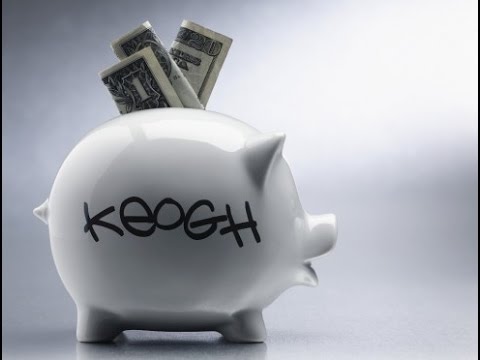Keogh Plans are not as popular as they once were but can still offer a powerful tax savings for a select few.
Back in 1962, retirement savings options were pretty limited and most people were either covered by their employer…or out of luck. This changed when U.S. Representative Eugene Keogh championed the creation of the plans that would bare his name.
Despite being less well-known, and harder to pronounce, the plans can still be a preferred choice for retirement savings if you qualify.
Keogh Plans…(pronounced key-o)

Similar to 401k plans offered by an employer, Keogh plans can be defined-contribution or defined-benefit. Defined-contribution plans offer either profit-sharing or money-purchase options.
Profit-sharing plans are most like other retirement accounts where you can contribute up to a certain limit or percentage of your net earnings, $53,000 or 25% of earnings for 2015. As an employer with a Keogh plan, you must extend benefits to your employees and contribute to their accounts. The business entity can also contribute up to 15% of a participant’s earnings to the account.
The money-purchase option allows for the largest contribution through a percentage contribution of net earnings, still 25% but up to $170,000 per year. The money-purchase plan requires the employer or person to elect a fixed-percentage of earnings to be contributed. This contribution percentage cannot be changed and a penalty may be assessed if it is not met in any particular year. As with the profit-sharing plan, if an employer elects a money-purchase plan, the same benefits must extend to employees.
Defined-benefit plans work like traditional pension plans but you decide the payout and the IRS calculates a required contribution. The stated annual benefit is based on salary and years of service with a maximum annual benefit of up to $215,000 for 2015.
As with other retirement savings plans, withdrawals before the account holder reaches 59 ½ years old may be assessed a 10% penalty on top of income taxes. Withdrawals from a Keogh plan, regardless of age, are taxed as normal income.
Visit the IRS page on Retirement Plans for the Self-Employed for more information on Keogh Plans.
Am I eligible to contribute to a Keogh Plan?
Keogh plans are available to self-employed persons and small business owners. To be eligible, a business must be a sole-proprietorship, partnership or limited-liability company (LLC). Incorporated businesses, their owners and employees are not eligible to participate in a Keogh plan.
If you qualify for a Keogh plan, you will either need to set up the paperwork through a pension company or a financial advisor with knowledge in the area. Paperwork and calculations are extensive so it’s not recommended that you set everything up by yourself. You may also buy a ready-made program established by a bank or insurer that has been approved by the IRS. These plans offer the benefit of lower cost but are not as customizable as plans established specifically for your company.
Advantages of a Keogh Plan

As with many other retirement savings options, the money paid into a Keogh plan is deducted from the current year’s taxes. With the potential for higher contributions, this makes the plan a viable option for high-income earners even against some of the drawbacks. The benefit from higher contribution limits, through a percentage of income, generally is not as pronounced until earnings exceed $200,000 a year.
Limitations on Keogh Plans
The amount of paperwork required to set up a Keogh plan is the primary drawback for most people. It is relatively easy to set up most retirement plans while a Keogh plan can require extensive calculations and professional help.
If an employer chooses a Keogh plan for the company, benefits must extend to employees as well. Employees do not contribute to the plan and all contributions are made by the employer. The requirement offers a great benefit to employees but employers need to plan accordingly before incorporating it into the business.
With money-purchase plans, you may owe a penalty of as much as 100% of the missed contribution if you fail to reach your established percentage of earnings. While high-income owners have preferred the money-purchase plan for its higher contribution potential, the requirement for a set percentage can be difficult to manage.
Similar to withdrawal rules for IRAs, you must start taking withdrawals from a Keogh plan when you reach 70 ½ years of age. If you are still working after this point, you may continue to contribute but must also withdraw money.
Keogh Plans: Frequently asked questions
What’s the difference between a Keogh Plan and an IRA?
Keogh plans are popular among the self-employed and small businesses because contribution limits are higher than with Individual Retirement Accounts. The maximum contribution for a Keogh Plan is $53,000 in 2015, or up to 25% of your net earnings, compared to the $5,500 limit for IRA contributions. For this reason, a Keogh plan can be a powerful way to reduce your tax bill. Keogh plans also offer choices for small businesses whereas an IRA is only for individuals.
What’s the difference between a Keogh Plan and a SEP or other self-employed plans?
Keogh plans were named after the U.S. congressman that championed them in 1962. The plans were expanded as part of the Economic Recovery Tax act of 1981. Until the tax law change of 2001, they were largely the only option for the self-employed and small business owners. Since 2001 when other self-directed 401k and self-employed options were formalized, the term Keogh is less often used but is still popular for some. Keogh plans involve much more paperwork and calculations compared to other self-employed or small business options but offer higher contribution limits.
Can I roll my Keogh Plan into a 401k plan if I go back to work?
You can roll your Keogh plan into a 401k plan as well as do a 401k rollover into a Keogh if you leave your employer.
What if I need money from a Keogh Plan before I reach 59 ½ years old, can I avoid penalties?
Exceptions on Keogh withdrawals are generally the same as with other retirement accounts but you should check with a financial professional before making a withdrawal. You may be able to avoid the early withdrawal penalty if you have un-reimbursed medical expenses exceeding 7.5% of your adjusted gross income or to pay for medical insurance premiums after losing your job.
Are there limits to what I can invest in with a Keogh plan?
Investing the money in your Keogh plan works just like in any other individual retirement account. You have complete control over the investments options and asset classes you want to hold.

